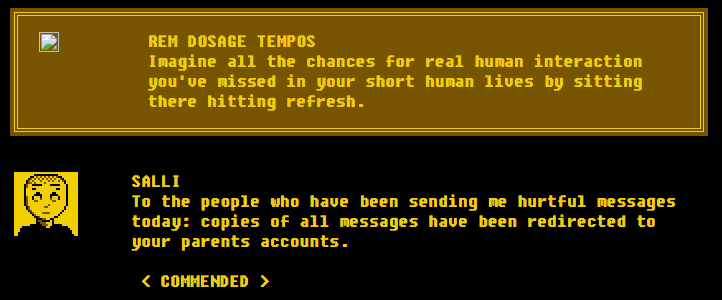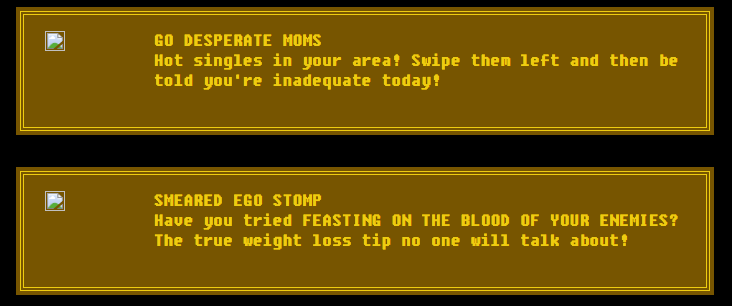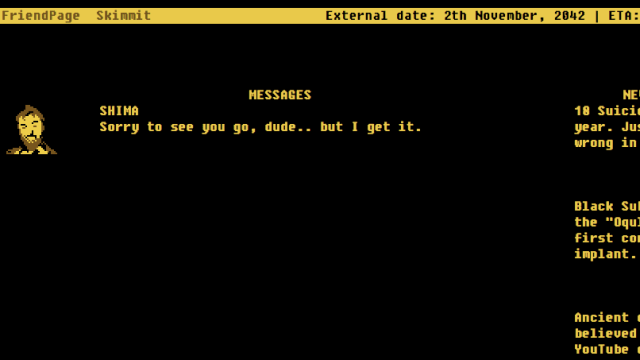At face value, Killing Time at Lightspeed looks like a browser-based text adventure, or perhaps some sort of dated social-media app you found on a phone you left in a drawer and forgot you had. But at its heart, KTAL is much more than that, using all the best elements of text-based adventures to bear a point-and-click story that never feels dull.
I was introduced to this game back when I was studying video game design and development. My class must’ve been about 15 people, and we were all waiting for an Unreal Engine update to install. Our tutor suggested that we check out this indie game, because we’d probably be able to play through it once before the update was complete. KTAL was made in one month, for the theme “Golden Age of Sci-Fi”, along with 14 other games, curated by Zoe Quinn and Alex Lifschitz.

The creator of KTAL, Sydney-based Gritfish describes the game as this:
You never know what will be the last thing you say to someone. On a transport ship, leaving earth, a passenger kills time by scrolling through the message of their social media feed. As the ship leaves and moves further and further away from home, the delay between sending messages and their arrival lengthens. What feels like minutes on the ship is hours, days, weeks, even years back on earth. Each refresh of the timeline is a tiny window into the past. What will you do in those precious few moments as the lives of everyone you know pass by?
It was the perfect game to explore simultaneously with a group of other people, because depending on what appealed to us, and what we clicked around on, the game would morph and show us different facets of the story. While a general idea of the story can be gleaned from a single play, it takes repeated playthroughs to get a real understanding of what’s going on back at home while you jet off to Gliese 667C.

KTAL interests me as a game because of the way it has not only created an enjoyable game, but it seems to be an intelligently crafted piece of literature as well. It is aware of its context, and knows the medium it has mimicked with an ironic intimacy. Upon first opening the game, you are greeted with a short blurb about your flight, and explaining that while the flight will take approximately 29 years, it will feel like just half an hour.
The game does not progress except when you refresh, meaning that there is no time limit on your exploration. It’s a pleasure clicking around, because for every piece of information integral to the storyline — whether it be obvious at the time or not — there are several other posts, referencing popular culture and hilariously incoherent spambots. On my first refresh of FriendPage’s “timestream” (read: newsfeed), I scroll through Blondie references, a post from a spambot called “DOG_QBOOKS”, ads for intergalactic travel providers and friends asking me if I made it to my flight without too much of a hangover. I feel right at home.
While seemingly frivolous at first, your friends’ updates and the news headlines take a sharp downturn into Huxley-esque dystopian tone. As technology, the law and human-cyborg relations all seem to collide, it’s sad to see what happens to your friends as their stories are woven, often through posts which could only be described as thinly-veiled criticisms of the society they’re inhabiting. You can even watch some relationships within your circles deteriorate online; this is voyeurism at its finest.

As years pass with every refresh, your home society deteriorates more and more rapidly; even the spambots’ once near understandable spoutings have been reduced to absolute gibberish. While sombre, the game retains the black humour that makes it so entertaining. It also cleverly touches on issues including religion, climate change, technology, surveillance, race, drug decriminalisation and sexuality, and through subtle sarcasm and the prompts the player is given, a commentary is formed on these topics. Quite a feat for a game made in only one month.
As a game created to reflect “The Golden Age of Sci-Fi” it succeeds in its endeavour. It’s Asimov meets Orwell, a dark adventure into a world having taken a divergent path from today’s earth, one which perhaps exists for the sole reason of showing us the human condition will be the same regardless of how advanced we become.
The game ends on a bittersweet (and somewhat abrupt) note. Things quieten and go out with a fizzle rather than a bang. Given its form, it’s entirely understandable that the game cuts itself off as such, that’s part of the point. However it does leave you longing for more, and wondering of the exact details of what happened to all these characters you’ve come to know. Despite this, the game is amazingly entertaining, and the attention to detail draws you in to a story which is not only fascinating to uncover, but which uncovers so much about our own society.
You can play Killing Time at Lightspeed by clicking this link.

Comments